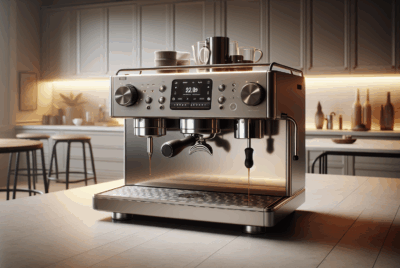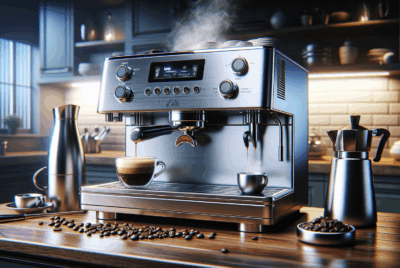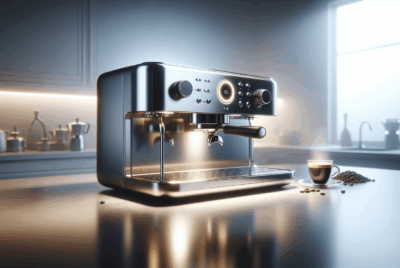How to Use Delonghi Espresso Machine: Expert Tips for Perfect Coffee
As an Amazon Associate, I earn from qualifying purchases, at no additional cost to you. Disclaimer
Making a great espresso at home is easy with a Delonghi espresso machine. I’ve found that having one of these machines transforms my coffee-making experience.
The sleek design and reliable performance make it a staple in my kitchen.

To make a perfect cup of coffee, simply grind your coffee beans, fill the portafilter, and press the button. It’s as straightforward as it sounds.
The machine does most of the work, ensuring the right blend and temperature.
Once you get the hang of it, experimenting with different brew strengths and flavors becomes enjoyable. It’s a wonderful way to start the day with a rich and aromatic cup.
Unboxing and Setting Up Your Delonghi Espresso Machine
When you first receive your Delonghi espresso machine, it’s important to carefully unpack and set it up. I’ll guide you through identifying the main components and preparing your machine for the first use.
Understanding Your Delonghi Espresso Machine Components
As you open the box, you’ll first see the machine itself, the Water Tank, and the Portafilter. These are key parts.
The Filter Holder usually comes attached to the portafilter. Be sure to locate the instruction manual, which is crucial for any troubleshooting.
Check if there are extra filters, a scoop, or a milk frother. This can vary by model. De’Longhi Espresso Machines sometimes include a descaling liquid. These items will help maintain your machine over time.
I’ve noticed the machine usually has protective plastic. Remove this before use.
Make sure no parts are missing by comparing with the checklist in your manual. All pieces should be present for a proper setup.
Initial Cleaning and Assembly
Before using, it’s a good idea to clean all removable parts. This ensures any residue from manufacturing or shipping is washed away.
I generally rinse the portafilter, filter holder, and water tank with warm water. Use a soft cloth for wiping the main unit to keep it clean.
Next, fill the water tank with fresh water and attach it to the machine. Ensure it clicks into place to avoid leaks.
I usually insert the filter holder into the portafilter, lock them together, and attach them to the machine.
Power up the De’Longhi by connecting it to a power source, and run a simple water brewing cycle. This step helps clean the internal parts.
You’re now ready to brew great espresso at home!
Operational Basics
Getting started with a Delonghi espresso machine involves a few essential steps. It’s crucial to make sure the machine is correctly turned on, filled with water, and preheated for the best brewing results.
Turning on the Machine
I start by locating the power button on my Delonghi espresso machine. It’s usually on the side or back.
Plug it into an outlet and press the power button once.
Wait for Indicators:
- Look for lights or symbols on the front panel.
- These tell me when the machine is ready to use.
It’s important to ensure the power cable is secure. If it’s loose, the machine might not turn on properly.
I always double-check the connection for safety and functionality.
Filling the Water Tank
Before brewing, I fill the water tank with fresh, filtered water. Avoiding tap water helps prevent mineral build-up.
Steps for Filling:
- Remove the tank from the back or side.
- Fill it to the indicated maximum line.
- Reattach the tank securely.
Filtered water also ensures better taste, as it doesn’t have the impurities that affect brewing temperature and quality.
Many Delonghi machines provide a water hardness setting to adjust, improving the life of the machine.
Preheating the Machine
Preheating ensures the water reaches the right brewing temperature.
I start by letting the machine run for a few minutes without the coffee.
Preheating Process:
- Turn on the steam function.
- Allow hot water to flow through the wand briefly.
Preheating the cup helps as well. A warm cup maintains the coffee temperature.
Keeping everything warm ensures a hot, consistent espresso shot every time. By following these steps, I make the most of my Delonghi espresso machine.
Grinding and Tamping

Grinding and tamping are key steps in making a great espresso with your Delonghi machine. Using quality coffee beans, a burr grinder, and proper tamping pressure can make a big difference in your espresso’s flavor.
Choosing Quality Coffee Beans
I start with fresh, quality coffee beans. Look for beans that are recently roasted for the best flavor.
Dark roasts are often preferred for espresso, but medium roasts can work well too. I avoid pre-ground coffee because it loses flavor quickly once exposed to air.
Buying whole beans lets me grind them just before brewing, keeping that rich aroma and taste intact.
Using the Burr Grinder
I use a burr grinder for consistent grind size. Unlike blade grinders, burr grinders crush beans evenly, which is important for espresso.
I set the grinder to a fine setting, similar to table salt. This ensures even extraction during brewing.
Grind size is critical because too coarse, and the water flows too quickly. Too fine, and it clogs the machine.
Applying Correct Tamping Pressure
I apply firm and even pressure using a tamper. Press down with about 30 pounds of force. This compacts the coffee grounds and creates a smooth surface.
It’s important to keep the tamper level to ensure even extraction. Uneven tamping can lead to channeling, where water finds an easy path and results in weak espresso.
I practice to get a feel for the right pressure.
Brewing Espresso

Brewing a good shot of espresso with a Delonghi machine involves precise steps. I focus on loading the portafilter, choosing the right brewing options, and understanding the brewing process for an excellent cup.
Loading the Portafilter
First, I make sure the portafilter is clean and dry. This ensures that no old coffee grounds interfere with the fresh brew.
I then fill it with the right amount of finely ground coffee to ensure proper espresso extraction. Using a tamper, I press the grounds evenly, which is crucial for consistent coffee strength.
The grounds should be level with the top edge of the portafilter. Once that’s done, I lock it into the machine securely to prevent any leaks while brewing.
Selecting Brewing Options
After loading the portafilter, I turn my attention to the machine’s brewing options. Most Delonghi machines offer buttons for selecting single or double espresso shots.
I choose based on my preference for coffee strength.
For a single shot, I press the single button and for a double, the double button. If available, I might also adjust settings for a stronger or lighter shot. This step is key in customizing the espresso to my liking.
Understanding the Brewing Process
Once I’ve selected the options, the brewing process begins. I need to watch as hot water is forced through the compacted coffee grounds.
The machine’s pump plays a vital role, ensuring the pressure is just right for optimal espresso extraction.
I keep an eye on the espresso as it pours out, often in a steady, golden stream.
From start to finish, this process typically takes about 25 to 30 seconds. Paying attention to this helps me achieve a rich flavor and perfect crema, the creamy foam that sits on top of a well-brewed espresso.
Milk Frothing Techniques

Frothing milk is an essential step in making delicious espresso-based drinks. Using a steam wand effectively will help create the right texture, whether you’re making microfoam or latte art.
Using the Milk Frother
I always start by ensuring the steam wand is clean. It’s important to purge it by expelling a little steam. This prevents old milk residue from entering the new batch.
Next, I fill a steel pitcher with cold milk—about a third of the way.
Cold milk froths better, giving me more control over the texture. I position the wand just below the milk’s surface, turning on the steam.
Moving the pitcher slightly helps incorporate air.
To heat the milk, I gradually raise the pitcher. I look for small bubbles and a consistent swirl. It’s ready when the pitcher becomes too hot to touch for more than a few seconds.
Creating Microfoam
To create microfoam, I start with the same cold milk in a steel pitcher. I keep the wand’s tip just below the surface and listen for a gentle hissing sound. This sound indicates bubbles forming.
While I steam, I move the pitcher in a steady circular motion. This helps in breaking down large bubbles.
My aim is to get a smooth and velvety texture.
Temperature is key. I avoid overheating the milk, as this can ruin the foam. Once it reaches around 150°F (65°C), it’s perfect for pouring.
Pouring for Latte Art
Pouring for latte art takes practice. I hold the cup at an angle and begin pouring from a bit of height, allowing the milk to mix with the espresso.
As the cup fills, I lower the pitcher, getting closer to the surface.
I gently wiggle the pitcher for designs like hearts or rosettas. The key is steady hands and patience.
Working too fast or too slow can affect the outcome. Once you get the hang of it, it adds a personal touch to every cup.
Crafting Coffee Specialties

Using a Delonghi espresso machine offers an exciting way to create and enjoy various coffee specialties. I will guide you through making perfect espressos and popular variations like lattes and cappuccinos, while also sharing unique recipes.
Making a Perfect Espresso
Creating a high-quality espresso involves precision and skill. First, I grind fresh coffee beans to a fine consistency. Using the right grind level is crucial for extracting rich flavors.
Even tamping is important, as an uneven surface can lead to bitter or weak espresso.
Next, I lock the portafilter securely and start the machine. The espresso should flow smoothly, looking rich and caramel-colored.
I aim for a 25-30 second extraction time for the best taste. A thick, golden crema on top indicates success. This aroma sets the foundation for crafting other coffee drinks.
Creating Lattes and Cappuccinos
To make a latte, I steam milk until it is creamy and slightly frothy. I pour the milk gently over a shot of espresso, forming a layered drink. The espresso’s strength combined with the milk’s sweetness creates a balanced flavor.
For cappuccinos, I froth the milk until it triples in volume. I then pour it over a shot of espresso. The milk should create three equal parts: espresso, steamed milk, and froth. The result is a drink with a richer, bolder taste compared to a latte.
Unique Recipes and Variations
Exploring different coffee recipes can lead to delightful discoveries. One favorite of mine is the caramel macchiato. I prepare it by adding a layer of caramel sauce, followed by steamed milk, and a shot of espresso on top.
I can also make a mocha by mixing chocolate syrup and espresso, then topping it with steamed milk and whipped cream. Adding cocoa powder enhances the chocolate flavor.
By experimenting with spices such as cinnamon or nutmeg or flavored syrups like vanilla, I create personalized coffee experiences suited to different tastes.
Cleaning and Maintenance
Keeping your Delonghi espresso machine in top condition involves daily clean-ups, regular descaling, and ongoing care. It ensures that your espresso tastes great every time and extends the life of your machine.
Daily Cleaning Routine
First, I turn off and unplug the machine. Then, I remove the drip tray and water tank.
I wash these with warm, soapy water. Next, I wipe down the exterior with a damp cloth.
Don’t forget the brew head. I use a damp cloth to clean it as well. I let everything air dry before reassembling.
Empty the coffee grounds after each use. It prevents old grounds from affecting the taste of fresh espresso. Keeping it clean makes every cup taste great.
Descaling the Machine
Descaling is vital for removing mineral build-up. I mix a descaling solution with water according to the instructions on the package. Then, I pour it into the water tank.
I turn on the machine and start the descaling cycle. This process can take some time, but it’s crucial for maintaining optimal performance.
Once the cycle is complete, I rinse the machine with clean water. Running a few cycles with fresh water ensures all descaling residue is removed. I do this every 1-3 months, depending on water hardness.
Long-Term Maintenance
In the long term, it’s important to check the condition of parts like the gasket and seals. I inspect them monthly for wear. Replacing them when needed prevents leaks and ensures a good seal.
Storing the machine properly keeps it safe from dust and moisture. Using filtered water can reduce mineral deposits, lessening the need for frequent descaling.
Keeping track of when I last performed maintenance helps. A simple calendar reminder can ensure regular attention to the machine’s upkeep. It’s about creating a habit for continuous care and reliability.
Troubleshooting Common Issues
Using a Delonghi espresso machine can sometimes present challenges such as water flow problems, taste adjustments, and knowing when to call an expert. I’ve outlined common issues and how to handle them.
Resolving Water Flow Problems
If your espresso machine isn’t dispensing water properly, the first step is to check the water reservoir. Make sure it’s filled and seated correctly.
I often find that air bubbles can cause blockages, so priming the pump helps. Sometimes, the water filter needs cleaning, which can be done by removing and rinsing it under warm water.
A clogged nozzle might also be the culprit. I use a pin or a needle to clear any debris that might be stuck. Don’t forget to check the pipes inside the machine for any signs of blockage. Regular descaling can also prevent water flow issues by removing mineral build-up.
Adjusting Brew Strength and Taste
Achieving the right taste involves adjusting the grind size of your coffee beans. Finer grinds lead to stronger flavors, while coarser grinds make for a milder taste.
I also experiment with the amount of coffee used; naturally, more coffee results in a bolder brew.
The length of extraction time is another factor. If the coffee tastes bitter, it might be extracting for too long, so I reduce the time. For sour-tasting coffee, I try extending the brewing duration. The temperature setting is key; ensuring it’s hot enough will improve flavor extraction.
When to Seek Professional Help
There are times when professional help becomes necessary. If I’ve tried all basic troubleshooting steps and my espresso machine still doesn’t work, I reach out to a certified technician.
Signs of electrical issues, persistent leaks, or broken components are reasons to call in an expert.
After warranty expiration, regular maintenance by a professional can extend the life of my machine. Having a technician inspect and service complicated parts like the heating element ensures optimal performance. It’s crucial to follow the manufacturer’s guidelines for service intervals to avoid voiding warranties.
Frequently Asked Questions
Using a DeLonghi espresso machine involves understanding its features and functions. I’ll guide you through common questions like how to operate the machine, symbols meaning, making lattes, using coffee pods, and more.
How do you use an espresso machine step by step?
To use the machine, first, fill the water tank. Then, add coffee grounds to the portafilter and attach it to the machine.
Turn it on and select the espresso option. The coffee will start brewing and fill your cup.
What do the symbols mean on a DeLonghi coffee machine?
Each symbol on the machine indicates a function. The cup icon starts espresso brewing. The steam icon activates the milk steamer. A water droplet shows the hot water function for making tea or americanos.
How do you make a latte with a DeLonghi espresso machine?
First, brew a shot of espresso as described above. Then, froth milk using the steam wand.
To do this, submerge the wand in milk and turn on the steam function. Pour the steamed milk over the espresso and mix gently.
What is the process for using coffee pods with a DeLonghi machine?
For coffee pods, open the pod compartment and insert a pod. Close the compartment and press the button for pod coffee. The machine will automatically adjust to brew from the pod.
How do you make espresso with a DeLonghi?
Fill the portafilter with fine coffee grounds and lock it in place. Press the espresso button on the machine. The device will brew a rich, concentrated shot of coffee into your cup, usually in under a minute.
How does the milk frother work on a DeLonghi espresso machine?
The frother releases steam to heat and froth milk. Position the steam wand in a jug of milk and turn on the steam.
The milk will become foamy and warm, perfect for cappuccinos or lattes.



